
The Mirror of Great Britain was a piece of jewellery that was part of the Crown Jewels of the United Kingdom during the reign of King James VI and I. It was pawned in 1625 and is considered lost.

The Mirror of Great Britain was a piece of jewellery that was part of the Crown Jewels of the United Kingdom during the reign of King James VI and I. It was pawned in 1625 and is considered lost.
The jewel was described in a 1606 inventory as follows:
Item, a greate and riche jewell of gould called the MIRROR OF GREAT BRITTAINE, containing one very faire table diamonde, one very faire table rubie, two other diamonds cut lozengwise, the one of them called the stone of the letter H. of SCOTLANDE, garnished with small diamonds, two rounde pearles fixed, and one fayre diamond cut in fawcetts, bought of Sancy." [1]
The National Galleries of Scotland collection includes a 1604 portrait by John de Critz of James wearing the Mirror of Great Britain as a hat jewel. [2] He wore and was painted wearing other jewels in a similar fashion, such as the Three Brothers, and a "feather" of gold set with diamonds. [3]
When Queen Elizabeth I died in 1603 after a 45-year reign, she was the last direct descendant of King Henry VIII, and the 'virgin queen' had been unmarried and childless. King James VI of Scotland seemed to have the best claim on the throne through his great-grandmother Margaret Tudor, and from as early as 1601, English politicians had maintained a secret correspondence with James to prepare for the succession. [4] When James VI ascended to the thrones of England and Ireland as James I in 1603, he was the first monarch to realise the promise of the 1502 Treaty of Perpetual Peace, which had brought the Scottish House of Stuart into the line of succession of the English House of Tudor.
To mark the momentousness of the occasion of this "Union of the Crowns", several pieces of art were commissioned, chief among them the Mirror. The jewel was created around 1603 by an unknown master craftsman – possibly the best-known of James's goldsmiths, Scotsman George Heriot, who had followed the king from Edinburgh to London. [5] To assemble the pieces of the Mirror, James had likely ordered existing Elizabethan jewellery to be broken up. [6]

The jewel was created in gold with five main stones set into it: four pale diamonds and a red ruby. The ruby and one of the diamonds were table-cut, while two further diamonds were lozenges. One of them was known as the Great H of Scotland or the Great Harry and had belonged to James's mother, Mary, Queen of Scots, who had been gifted the stone by Henry II of France. [7] The final stone – dangling underneath the four other jewels, as can be seen in the 1604 painting – was the Sancy diamond. The Sancy had originally belonged to Charles the Bold, Duke of Burgundy, just like the Three Brothers, another of James' crown jewels. The diamond had acquired its name when it was bought in the 16th century by French diplomat Nicolas de Harlay, seigneur de Sancy, who eventually sold it to James. The Mirror was also decorated with two large pearls and a number of smaller diamonds. [8] A contemporary source estimated the total cost of the Mirror at over £70,000. [9] James would typically wear the piece as a hat jewel, with the ruby at the nine o'clock position to the left of the diamonds. [6]
When James died in March 1625, the jewel passed to his son Charles I. [10] [11] In his decades-long struggle with the Parliament of England that would ultimately lead to the First English Civil War, Charles continuously asserted the divine right of kings, which meant personal ownership of crown jewels such as a Mirror. Plagued by financial difficulties, in 1625 Charles took the drastic step to pawn away several important items of jewellery in the Netherlands, most likely in The Hague, one of the centres of the jewel trade. While Charles managed to eventually scrape together enough money to redeem certain jewels some 14 years later in 1639, [12] the same could not be said for the Mirror. The jewel was likely sold to Hague jeweller and gemstone dealer Thomas Cletcher, who recorded an item very similar to the Mirror in his sketchbook with the note that it had been "commissioned by Coninc Jacobus". [13] The theory is bolstered by the fact that it was also Cletcher who again acted as middleman or buyer when Charles's wife Henrietta Maria attempted to sell off even more of the crown jewels in 1644.
The Mirror's journey as a distinct piece of jewellery ends after the sale, however. It was split up and its constituent stones sold or re-used. [14] The two remaining pearls were sold off in 1630 by James Maxwell, a groom of the bedchamber. [15] The Sancy diamond was the only piece of the Mirror to ever be reclaimed, but it was eventually pawned again by Charles's son James II, after which it became part of the French Crown Jewels. [16] The Sancy is now in the collection at the Louvre in Paris.

The Crown Jewels of the United Kingdom, originally the Crown Jewels of England, are a collection of royal ceremonial objects kept in the Tower of London, which include the coronation regalia and vestments worn by British monarchs.
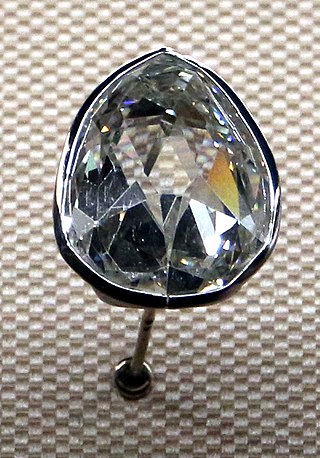
The Sancy, a pale yellow diamond of 55.23 carats (11.046 g), was once reputed to have belonged to the Mughals of antiquity, but it is more likely of Indian origin owing to its cut, which is unusual by Western standards. The stone has been owned by a number of important figures in European history, such as Charles the Bold, James VI and I, and the Astor family.

George Home, 1st Earl of Dunbar, KG, PC was, in the last decade of his life, the most prominent and most influential Scotsman in England. His work lay in the King's Household and in the control of the State Affairs of Scotland and he was the King's chief Scottish advisor. With the full backing and trust of King James he travelled regularly from London to Edinburgh via Berwick-upon-Tweed.

Nicolas de Harlay, seigneur de Sancy (1546–1629) was a French soldier, diplomat, and gem collector.
Sir John Spilman was a Lindau, German-born entrepreneur who founded the first commercially successful paper-mill in England, establishing a factory on the River Darenth in Dartford, Kent in 1588. Spilman was also jeweller to Queen Elizabeth I, and was knighted by King James I.
Sir William Herrick or Hericke was an English jeweller, courtier, diplomat and politician who sat in the House of Commons at various times between 1601 and 1622.

The Portuguese crown jewels, also known as the Royal Treasure, are the pieces of jewelry, regalia, and vestments that were used by the Kings and Queens of Portugal during the time of the Portuguese Monarchy. Over the nine centuries of Portuguese history, the Portuguese crown jewels have lost and gained many pieces. Most of the current set of the Portuguese crown jewels are from the reigns of King João VI and King Luís I.
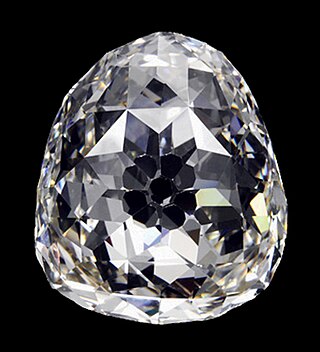
The Beau Sancy is a 34.98-carat diamond originally mined in India, which is cut in a modified pear double rose-cut shape. Since appearing in Europe in the 16th century, the Beau Sancy has been owned by a number of European royal houses, among them the House of Medici and the kings of England and Prussia. After more than 300 years in the possession of the House of Hohenzollern, the diamond was sold in 2012 at Sotheby's auction in Geneva for $9.57 million to an anonymous buyer.
Costume and gold and silver plate belonging to Elizabeth I were recorded in several inventories, and other documents including rolls of New Year's Day gifts. Arthur Jefferies Collins published the Jewels and Plate of Queen Elizabeth I: The Inventory of 1574 from manuscripts in 1955. The published inventory describes jewels and silver-plate belonging to Elizabeth with detailed references to other source material. Two inventories of Elizabeth's costume and some of her jewellery were published by Janet Arnold in Queen Elizabeth's Wardrobe Unlocke'd.
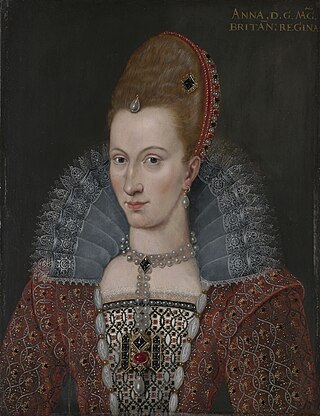
The Great 'H' of Scotland was a jewel belonging to Mary, Queen of Scots comprising a large diamond, a ruby, and a gold chain. It was broken up in 1604 and made into the Mirror of Great Britain for James VI and I.
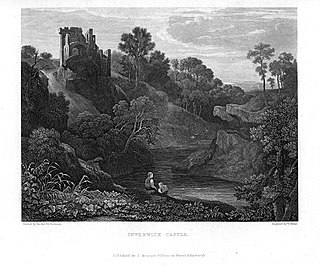
James Maxwell, 1st Earl of Dirletoun was a Scottish courtier and landowner, and Black Rod. He was involved in selling royal jewels.
Arnold Lulls was a Flemish goldsmith and jeweller in London. He served the court and made several pieces intended as diplomatic gifts.

The Three Brothers was a piece of jewellery created in the late 14th century, which consisted of three rectangular red spinels arranged around a central diamond. The jewel is known for having been owned by a number of important historical figures. After its commission by Duke John the Fearless of Burgundy, the jewel was part of the Burgundian crown jewels for almost 100 years, before passing into the possession of German banker Jakob Fugger.
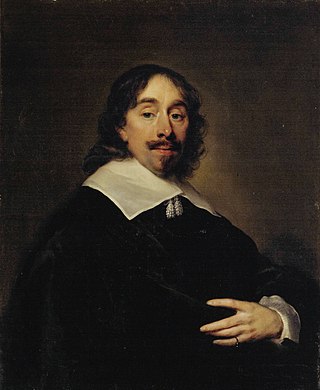
Thomas Cletcher was a Dutch jeweller, goldsmith, and gem dealer from The Hague, who was involved in several transactions of jewels of historical significance, and also served as the city's mayor from 1652 to 1657.
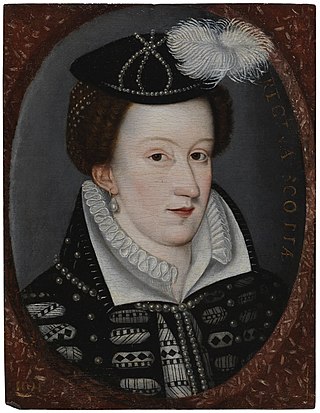
The jewels of Mary, Queen of Scots (1542–1587), are mainly known through the evidence of inventories held by the National Records of Scotland. She was bought jewels during her childhood in France, adding to those she inherited. She gave gifts of jewels to her friends and to reward diplomats. When she abdicated and went to England many of the jewels she left behind in Scotland were sold or pledged for loans, first by her enemies and later by her allies. Mary continued to buy new jewels, some from France, and use them to reward her supporters. In Scotland her remaining jewels were worn by her son James VI and his favourites.

The jewels of Anne of Denmark (1572–1619), wife of James VI and I and queen consort of Scotland and England, are known from accounts and inventories, and their depiction in portraits by artists including Paul van Somer. A few pieces survive. Some modern historians prefer the name "Anna" to "Anne", following the spelling of numerous examples of her signature.

The jewellery and jewels owned by James V of Scotland are mainly known from the royal treasurer's accounts and inventories. James V reinforced his authority by lavish display.

An inventory of the jewels of Mary I of England, known as Princess Mary in the years 1542 to 1546, was kept by her lady in waiting Mary Finch. The manuscript is now held by the British Library. It was published by Frederic Madden in 1831. Some pieces are listed twice. Two surviving drawings feature a ribbon with the inscription, "MI LADI PRINSIS".
Christophe de Harlay, Count of Beaumont (1570–1615) was a French politician and diplomat who served as ambassador to England.

James VI and I (1566–1625), King of England, Scotland, and Ireland, died on 27 March 1625 at Theobalds, and was buried at Westminster Abbey on 7 May 1625.
{{cite book}}: CS1 maint: multiple names: authors list (link)